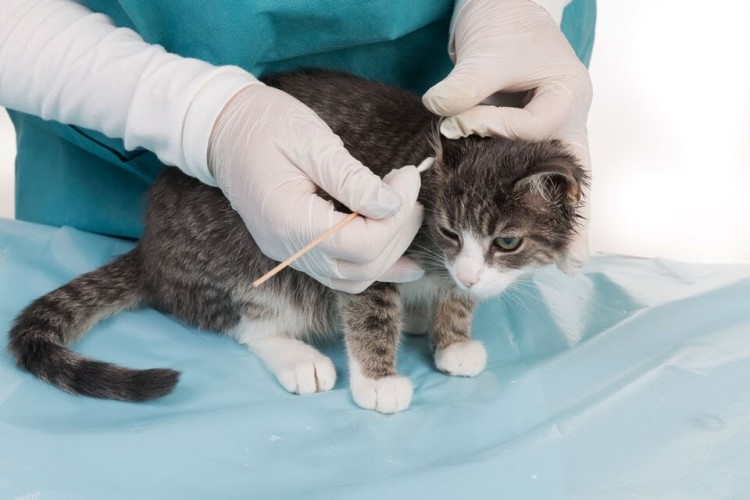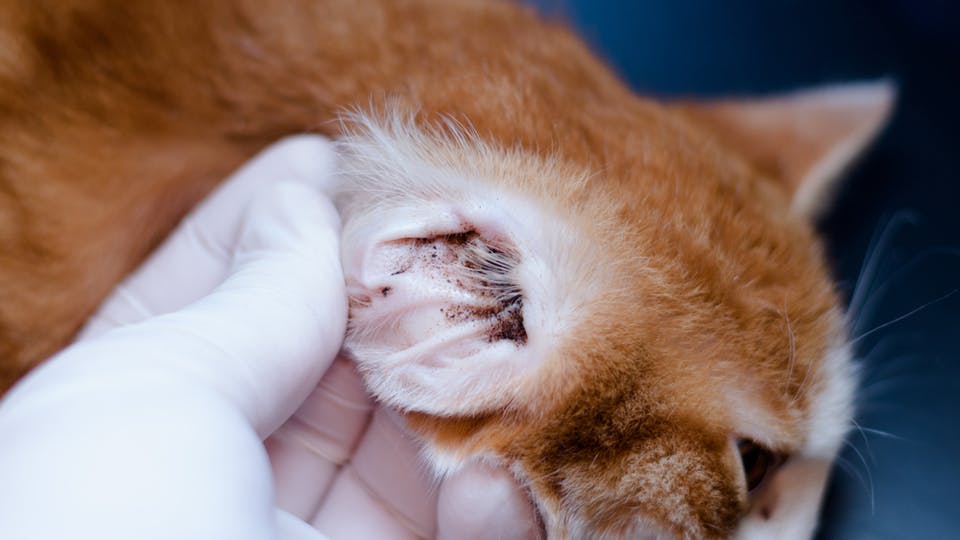Is your cat shaking its head or scratching its ears more than usual? Chances are it might have ear mites. These tiny parasites are very common in felines and highly contagious. Even though ear mites aren’t usually life-threatening, they can cause obstructions in the cat’s ear canal and cause the animal to scratch excessively in discomfort. This might cause one or more blood vessels in the ear to break, resulting in bleeding that requires surgery.
Read on to find out how ear mites affect your cat’s health and what you can do to prevent them.
Pro tip: Ear mites in cats can cause ear infections that may develop into a chronic problem. In that case, treatment may include more expensive medications, deep ear flushes, referrals for allergy testing, and food trials. Fortunately, pet insurance covers the treatment of chronic conditions like ear infections, allowing you to care for your cat without stressing about money.
Table of Contents:
- What are ear mites?
- How are ear mites transmitted?
- Can humans get ear mites from cats?
- What are the symptoms of ear mites in cats?
- How do you diagnose ear mites in cats?
- How do you treat ear mites in cats?
- How long does it take to get rid of ear mites?
- Can you prevent ear mites in cats?
- Key Takeaways
What are ear mites?
Ear mites are microscopic parasites that live inside the ear canal where they feed off ear wax and skin oils. The most common ear mite in cats is the species Otodectes cynotis.
It takes about three weeks for an ear mite to develop into an adult. Adult mites live for about two months, during which time they reproduce. Ear mites can survive for a limited time in the environment and their entire life cycle takes place on the host animal.
Ear mites are very common and can cause severe itchiness and irritation of the ears, as well as blockage of the ear canal if left untreated. In more severe cases, these parasites can also lead to ear or skin infections. Luckily, even though ear mites can have harsh effects on felines, they’re fairly easy to remove. Pet parents can easily identify a potential problem due to the brown discharge in the cats's ear.
They are usually found in the ears but they can also drift out onto the body, leading to itchiness and irritation of the skin.
How are ear mites transmitted?
Ear mites are highly contagious and make up more than 50% of all feline ear infections. Usually, they're spread by contact with another pet that has the condition. Ear mites in cats could also be caused by contact with a bed or toy belonging to an infected animal, or by improper ear cleaning after exposure to an infected animal. These parasites are especially common in young kittens.
Can humans get ear mites from cats?
Ear mites don’t survive for long on humans and therefore, they don’t cause long-term infections. However, in rare cases, the parasites might transiently hang out on humans (usually on extremities) and produce a temporary rash upon skin irritation.
 (Image source: Small Door Veterinary)
(Image source: Small Door Veterinary)
What are the symptoms of ear mites in cats?
To catch the problem early on, be sure to watch out for the following symptoms of ear mites in cats:
- Constant scratching of the ears
- Dark red scabs or scratches in and around the ears
- Hair loss in and around the ears
- Inflammation of the ear
- Strong and unpleasant odor
- Brown discharge (that looks like coffee grounds)
- Constant head shaking
- A big blood blister on the ear (aural hematoma), caused by rupture of tiny blood vessels in the ear's cartilage
How do you diagnose ear mites in cats?
It's very important to take your pet to the vet for a proper diagnosis, especially since ear mites are quite difficult to detect with the naked eye. Irritation in your cat’s ear can also be caused by allergies. Without visiting the vet, many pet parents are unaware that their pet is suffering from a yeast or bacterial ear infection, which can lead to inappropriate treatment and worsening of the condition.
When diagnosing a cat with mites, a vet will probably look at its medical history to determine whether the clinical signs could be a result of a hereditary ear disorder. Be sure to let your vet know if your pet has had exposure to infected or unfamiliar animals.
A diagnosis is made by observing the ear mite, which is usually done either by microscopic examination of discharge from the cat’s ear or by examination of the ears with an otoscope. If the ears are very sore, your cat might need to be sedated.
How do you treat ear mites in cats?
There are several ways to treat mites, all non-invasive and fairly simple. The vet will first clean your cat’s ears thoroughly in order to remove as many ear mites as possible. Then, they may recommend injections (e.g. ivermectin), single-use products (like Revolution®, Advantage Multi®, Bravecto®, and Simparica®), or topical medications.
There are no products licensed to kill mites on a pet’s skin or around the house, but flea control products are effective. Note that none of these medications can penetrate the eggs, so treatment is directed at killing the larval and adult forms, which usually require multiple rounds. The treatment duration may vary but doesn’t usually take longer than a month.
These parasites come with a high risk of infection, so vets often prescribe antibiotic treatment or ear drops, as well as antiparasitic topical medications that are applied in and around the ear. These topicals eliminate ear mites completely and are usually prescribed for a period of two to three weeks.
For successful treatment of ear mites in cats, it’s important to follow the dosage schedule provided by your vet. These medications might be time-consuming to apply regularly, but some of them can also treat secondary yeast and bacterial infections while calming inflammation.
During the healing period, you might need to gently clean your cat's ears of debris in order to speed up recovery and relieve your pet's discomfort. If he or she allows, you can simply use with a gentle cotton swab and ear cleaner. Depending on the pet and the amount of buildup, a vet’s assistance might be required.
All pets in the household should be treated at the same time, even if they aren’t showing any symptoms. Be sure to keep your cat away from other pets until the end of treatment to reduce the risk of spreading the infection. After prescribing a specific treatment plan, your vet might also want to see your cat back for a checkup in one to three weeks to confirm the mites are gone for good.
Pro tip: Pet insurance plans can help by reimbursing a portion of your cat’s medical bills. You can purchase a comprehensive “nose-to-tail” pet insurance policy that covers a wide range of health-related problems, including common illnesses like ear infections.

How long does it take to get rid of ear mites in cats?
Ear mites usually last three weeks before the adults die and a new life cycle begins, so it's best wait at least that long before considering your pet completely in the clear of these microscopic parasites.
The itchiness should begin to calm down in about one to two days as the medication takes effect, but you should call your veterinarian if there’s no improvement.
Make sure to finish the treatments completely to remove all traces of the mites in your cat's ear. If any symptoms start to reappear, be sure to return to your vet. It's possible that the same medication won’t work if the ear mites have become resistant to past treatments, and the vet will have to prescribe a new treatment plan.
Can you prevent ear mites in cats?
You can prevent cat ear mites by using appropriate antiparasitic treatments. Consult your veterinarian about which product is suitable for your cat and whether their flea medication defends against mites.
It’s also important to maintain a clean environment for your pet. Regularly wash their bedding, vacuum the upholstery, rugs, and carpets, and treat these areas with flea spray to prevent future outbreaks.
Key Takeaways
- Mites are a common parasite in cats that feed off skin debris in the pet's ear canal.
- These tiny parasites can rarely be seen by the naked eye and require diagnosis by a veterinarian.
- A range of treatments are available for ear mites in cats; flea medication can also be used to protect your feline in the future.
- If you suspect your cat has ear mites, contact your veterinarian as soon as possible to prevent the issue from worsening.
